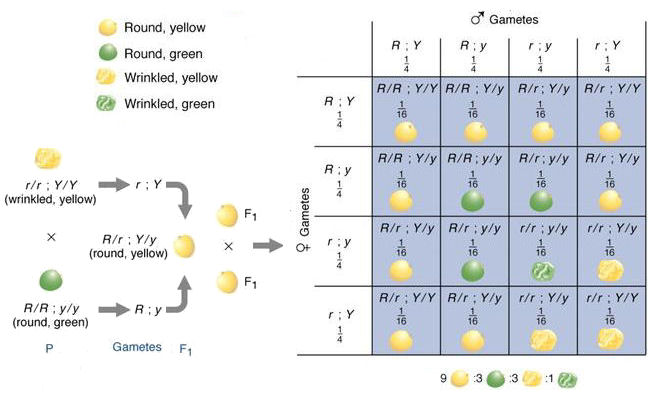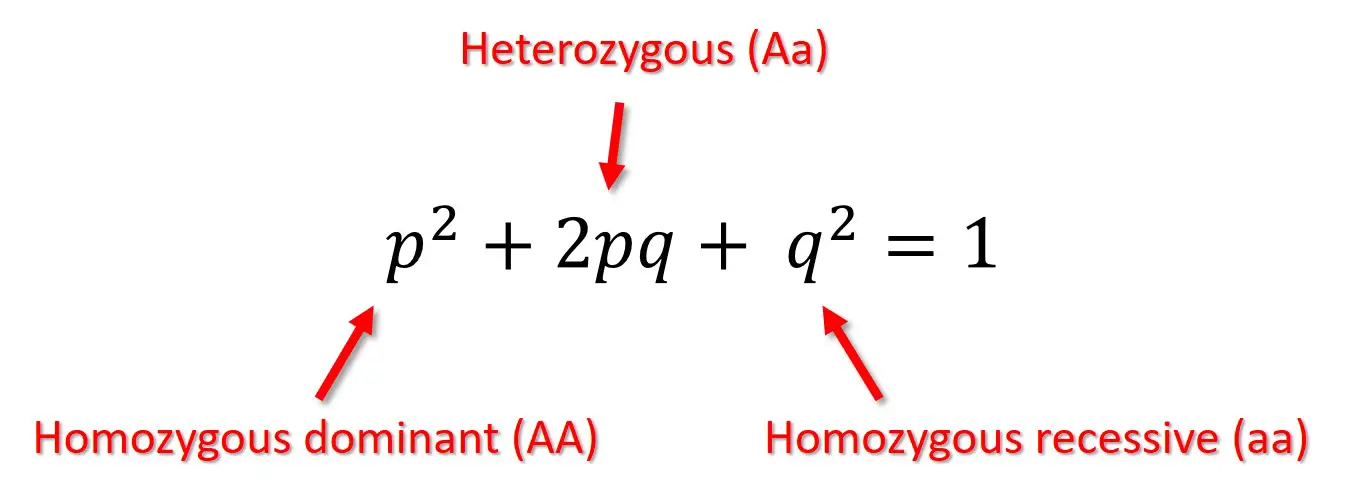Topic 7: Genetics, populations, evolution and ecosystems
- Created by: emmanuela_o
- Created on: 16-01-20 17:14
Monohybrid inheritance
- Monohybrid inheritance is when a phenotype or trait is controlled by a single gene.
- An example is crossing pea plants, there is a cross between a pure breeding green podded pea plant (dominant) and a yellow podded pea plant (recessive),
- All plants will have grean pea pods because they all possess the dominant tree pod allele.
Dihybrid Inheritance
- Dihybrid inheritance is when two characteristics are studied and is determined by two different genes that are present on two different chromosones at the same time.
- For example, in the diagram you can see the results from crossing round, yellow seeds (both dominant) with a plant pure breeding for wrinkled, green seeds (both recessive).

Co-dominance and Multiple alleles
- Co-dominance is when two phenotypes are expressed such as when birds have feathers that are both black and white.
- A further key example of co-dominance is shown in human blood ABO blood groups. There are three alleles that are associated with the immunoglobulin gene (gene 1). these lead to different antigens on their surface.
- There are two homologous chromosones that cause this and therefore two loci.
Sex Linkage
- The expression of an allele dependent on the gender of the individual as the gene is located on a sex chromosone. Humans have 22 pairs of autosomal chromosones that are not involved in sex determination, and one pair of sex chromosones, called either X or Y.
- XY - Males - have one of each type of sex chromosone
- ** - Females - have two X chromosones
- most sex linked traits are located on the X chromosones. therefore females will carry two alleles of sex linked gene, but males will only carry a single allele.
Autosomal Linkage
- In an autosomal linkage two or more genes are on the same autosomal chromosone

Epistasis
- In epistasis, the interaction of different loci on the gene, one gene locus affects the other gene locus. One gene loci acn either mask or suppress the expression of another gene locus
- Recessive epistasis occurs when the presence of a recessive allele prevents the expression of another allele at a second locus.
- Recessive epistasis gives the ratio of 9:3:4.
- Dominant epistasis is when a dominant allele at one locus completely masks the alleles at a second locus
- Dominant epistasis gives a ratio of 12:3:1
Chi-squared test
- A statistical test to see if the results of an experiment fit the theory.
- Actual results will never perfectly match the expected results
- NULL HYPOTHESIS - Any difference is purely down to chance
- Squaring removes any negative values
- If our calculated value for x2 is less than the critical value for p=0.05 we accept the null hypothesis.
CRITERIA - large sample size, discrete categories (e.g red, white, blue), raw count data (not percentages), used to compare theoretical data vs. experimental data.
Populations
- Allele Frequency - the proportion of organisms in the population carrying a particular allele
- Gene pool - the total information from all genes and alleles of the breeding individuals in a population at a particular time
- The Hardy-Weinburg equation can be used to estimate the frequency of alleles in a population and to see whether a change in allele frequency is occuring in a population over time
- in order to do this no mutations occur to make new alleles, there is no movement of alleles into or out of the population by migration, the population is large, there is no selection, so every allele has an equal chance of being passed to the next generation, mating is random .
Hardy Weinburg

Variation in Phenotype
There are variations in the alleles of genes for members of the same species due to a number of factors such as:
- Random fertilisation: the gametes that are carrying different alleles will join together randomly
- Meiosis: meisosis is the nuclear division that creates gametes and means that alleles will be assorted in the gametes at random
- Mutation: the mutation of an allele can go on to lead to the creation of another new allele which can be passed to the next generation
There may also be environmental influences, with the majority of phenotypic traits being influences by environmental factors.
Evolution & Natural Selection
Natural Selection - the process where individuals that are well adapted to their environment, survive and reproduce at the expense of less-well adapted individuals.
- Charles Darwin believed in common ancestry and that new species form by gradual changes over the generation
- If there is a change in the environment some genotypes may make organisms more likely to survive long enough to reproduce and pass their genes on to their offspring i.e. they are better adapted to their environment
- Over time the proportion of individuals with the favourable genotype will increase in the population.
Conditions for evolution
- variation - differences between individuals
- heredity - must be heritable
- means of selection - must be a mechanism or pressure that selects some variables for the next generation
Types Of Selection
Stabilizing selection:
- All populations have a 'carrying capacity'
- Environmental factors limit population growth
- They offer environmental resistance to population site. These can be
-Abiotic factors
-Biotic factors
- Stabilizing - selection pressure towards the centre increase the number of individuals at the modal value
- Disruptive - selection pressure towards the extremes creates two modal values
- Directional - selection pressure towards one extreme moves the modes in this direction
Speciation
- Speciation - formation of a species after a population becomes separated and cannot interbreed
- Allopatric speciation is caused by a physical. As the two groups become separated and reproductively isolated the result is that the gene flow is reduced.
- They become separate species
- Sympatric speciation is where new species evolve from a single ancestral species when inhabiting the same geographic region
- Genetc Drift - danger of small breeding population is that some alleles may not get passed on into the future
-Here a change in allele frequeny occurs by chance because only some of thr organisms in each generation may reproduce.
-This reduces the ability to adapt to environmental change
Populations in ecosystems
- A community is all of the populations of different species living and interacting in a place at the same time.
- An ecosystem is the dynamic interaction between all the living (biotic) and non-living (abiotic) factors in a given area.Within an ecosystem, every organism occupies a specific ecological niche A niche includes all the abiotic and biotic conditions of the environment which organisms are adapted to. The carrying capacity is the maximum population size that can be maintained over a period in a particular habitat.
The limiting factors of the carrying capacity include abiotic factors:
- Temperature & pH - each species has its optimum levels, anddeviations from this optimum reduces population growth
- Light - low light levels reduce the carrying capacity of producers, reducing the population size of consumers
- Water - low water availability reduces the population size
The limiting factors of the carrying capacity include biotic factors:
- Interspecific competition (between different species)
- Intraspecific competition (within the same species)
Predation
Predation is when one species (the prey) is caught and eaten by another species (the predator).
- The size of a population can be estimated by:
- Randomly placing quadrats, or quadrats along a belt transect, for slow-moving or non-motile organisms. Can count the number of individuals of each species in the quadrat or percentage cover.
- The mark-release-recapture method for motile organisms.
- It assumes there is no deaths, births, migration, marking has no effect and enough time for the animals to mix.
Succession
- Succession is the variety of processes that occur over time in a species that occupy a certain area.
- Primary succession is the progressive colonisation of bare rock or other barren terrain by living organisms.
- The area is first colonised by the pioneer species, changing the abiotic factors to be less hostile for other species to survive.
- Different species may be present at each stage, who change the environment so that it becomes more suitable for other species with different adaptations but less suitable for the previous species - changing biodiversity.
- The climax community is when a stable state is reached, where there is high biodiversity and a number of new species.
- Secondary succession is the recolonization of an area after an earlier community has been removed or destroyed.
Conservation
- Conversations is the maintenance of biodiversity, including diversity between species, genetic diversity within species and maintenance of a variety of habitats and ecosystems.
- Conservation involves active human involvement and is often orientated around managing a community by halting succession, to preserve species that would be extinct by the climax community being established.
- The rate of growth of the human population creates an increasing demand for raw material and food. A balance between conversation and human needs is necessary in order to maintain the sustainability of natural resources.


Comments
No comments have yet been made